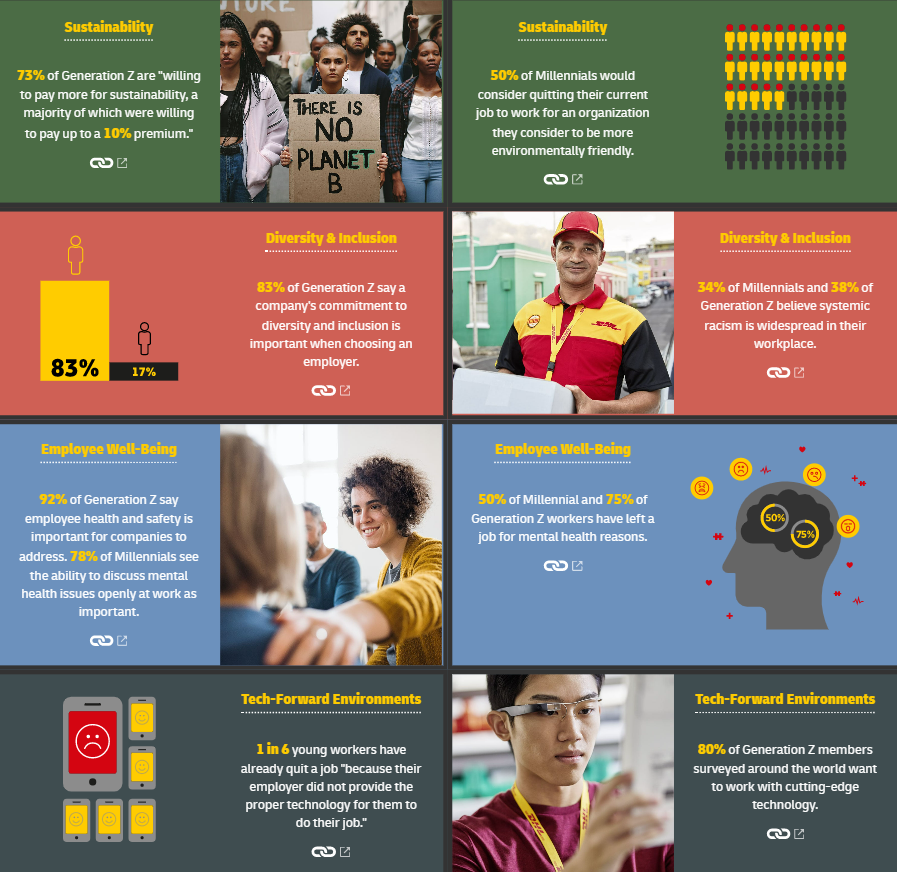DHL’s latest trend report ‘Future of Work in Logistics’ offers valuable insight into the three forces of change that are sculpting and accelerating the future of work within the logistics industry.
Shifting demographics, technology advancements and the Covid-19 pandemic are key factors that have, and will continue to, fundamentally change the logistics industry at a pace and scale never seen before.
The report examines how the concept of work – the ‘roles, responsibilities, systems, schedules, tools, and environments of workers’ will change in supply chains over the coming decades.
Shifting demographics
Over the next decade logistics organisations are going to experience a shift in the makeup of their workforce, as employees who preceded the invention of the internet in 1983 retire and become outnumbered by later generations who are digital natives.
The report analyses a demographic ‘changing of the guard’ – how this alters the makeup and foundations of the workforce, and the implications this has for the logistics industry.
Baby Boomers 1946-1964
This generation is estimated to represent 20% of the global working-age population.
Those coming to the twilight of their working career in their 50s, 60s and 70s are settling down for retirement, the rate of which has been accelerated by the Covid-19 pandemic.
Through their wisdom, knowledge and leadership, Baby Boomers have shaped the underlying foundations and working practices of today’s logistics industry.
Generation X 1965-1980
Gen Xers have witnessed the progression of technology from analogue to digital, the inception of the internet in 1983, and the preceding birth of e-commerce.
It is estimated that over 50% of all leadership roles worldwide are held by Gen Xers.
As Baby Boomers continue to retire, Gen Xers will progress to become the most senior supply chain employees over the coming decade.
Millennials 1981-1996
Millennials are expected to represent 40% of the global working-age population by 2030, thus forming the largest proportion of the workforce.
This generation has grown with the internet and has witnessed technology advance exponentially worldwide.
They are tech savvy and will fill the bulk of new job openings and will also lead the digital transformation of global supply chains.
Generation Z 1997-2012
A high percentage of Gen Z’s grew up with smartphones, tablets and advanced computing systems.
They are therefore considered ‘true’ digital natives, and form 26% of the current world’s population, making them the largest generation group currently alive.
Despite this, the vast majority are still in education and have yet to experience their first job or any relative workplace environment.
Their knowledge and skill sets have been moulded by advanced technology throughout their entire life, and their tech savvy nature will be invaluable to future operations in the logistics industry post 2030.
Generation Alpha 2013-2025
The first generation to be entirely born in the 21st century, this generation will grow up in a hyper-connected world alongside the implementation and development of advanced artificial intelligence, advanced automation and 5G networks.
They will be crucial to supply chains as they will have a tech-first, modern mindset.
What does this all mean for the future of the logistics industry?
83% of Generation Z say a company’s commitment to diversity and inclusion is important when choosing an employer.
Within the logistics industry organisations are becoming increasingly concerned about an influx of losses of institutional knowledge, as Baby Boomers and early Gen Xers with decades-long experience leave in their droves.
This creates an intellectual vacuum that ultimately needs filling.
Employers also need to adapt to the different needs and preferences of younger generations, and this continued transformation of people in the workforce is accelerating a widespread shift of values in the workplace.
Different social and political viewpoints, that are formed as a by-product of different eras, begin to permeate organisations. Millennials and Gen Zers, for example, are highly conscious about social issues and their wider impact.
Issues such as sustainability, inclusion, diversity, mental health and equality are important to them, both in the workplace and in their everyday lives.
The infographic below, included in DHL’s trend report, provides statistics which reflect and quantify this change in the workplace.

The Future of Work in Logistics infographic
Logistics companies must therefore accommodate and nurture these values, ensuring that the company’s policies, ethos and culture represents the shifting views of their workforce.
Technology Advancement
It is estimated that 29% of all current workplace tasks are done by machines. This is expected to grow to 52% by 2025. The progression to an almost fully automated supply chain, however, is expected to be a gradual process over thirty years, during which technology will supplement and collaborate with human labour, as opposed to fully replacing and competing with it.
The most significant driver of change, which is advancing and reshaping the future of the logistics industry, is the advancement of technology.
From advanced automation to artificial intelligence, technological innovations continue to impact the foundations of the logistics supply chain in order to make it more efficient, accessible, and environmentally sustainable.
Because of automating technology, workers on facility floors and in the office are seeing their roles fundamentally transform as they become essential to ensuring that these new technologies are operated, maintained and optimised.
DHL’s report included eight statistics (shown below) which quantify the exponential rate at which technology is advancing.

Future of Work in Logistics Infographic demonstrating the rate at which technology is advancing
Covid-19 Pandemic
The Covid-19 pandemic has upended businesses across every industry worldwide and posed unprecedented challenges to every entity of the logistics supply chain.
It has initiated and accelerated organisational and industrial changes at an unprecedented rate.
Changes which would typically take decades have instead been implemented in a matter of years.
From working from home, to greater scrutiny on health and safety measures, the pandemic has forced organisations to evaluate their procedures and embrace alternative ways of conducting business.
It has fundamentally changed the way we work and our perception of work permanently.
It has also changed the way we shop too, with e-commerce sales experiencing an unprecedented boom (represented below) and creating new opportunities and challenges for global supply chains.
It has created a surge in demand for logistics labour to help fulfil, transport and deliver the high volume of orders placed online.
Amazon has reportedly hired 450,000 people since the start of the pandemic and plans to hire another 125,000 people (primarily Millennials and Gen Zers) across the U.S. in its fulfilment and transportation divisions.
There are now a plethora of advanced technologies that have become priority investments for logistics companies as a result of the pandemic.
Organisations have also accelerated the implementation of advanced technologies, such as visibility tools, automation, contactless and flexible delivery technologies, and IoT (Internet of Things) sensors in order to add efficiency and resiliency to their supply chains.
Other technologies such as Artificial Intelligence, Machine Learning, IoT, Cloud, Delivered-at-Place and Control Towers have allowed companies to function better remotely, as work from home policies become permanent mainstays.
Conclusion
DHL’s ‘Future of Work in Logistics’ report offers valuable insights into the pressures that are impacting supply chains across the globe.
Organisations within the logistics sector should heed their report and its concepts in order to remain competitive and relevant in a fast-changing industry that has multiple vulnerabilities, as were highlighted during the pandemic.
Businesses need to understand the shifting needs, motivations and cultures of their workforce who are the bedrock of their organisation in order to remain competitive and relevant.
This will aid the successful adoption and utilisation of advanced technology, and the overall efficiency and sustainability of the global supply chain to ensure that it can better cope with future pressures.







